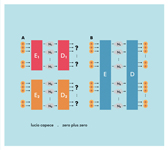|
|
 |
Dusted Reviews
Artist: Lucio Capece Album: Zero Plus Zero Label: Potlatch Review date: Jun. 6, 2012 |

|
|
|
 |
I don’t know what Lucio Capece does at his day job, or if he has one, but if his solo debut is any indication, he’s got some heady hobbies. Zero Plus Zero’s title and cover art are cribbed from quantum information theory, and while it’s easy for anyone to reference advanced physics precepts and adorn their album’s artwork with inscrutable diagrams, one gets the sense that Capece isn’t just trying to seem smart. The album’s music sounds like a series of scientific experiments, undertaken within specific parameters in order to observe the often minor variance in the results. It’s methodical minimalism made with instrument parts, equalizers, cardboard tubes, and an attentive ear.
An Émile Durkheim quote on the inside of the album’s gatefold concerns the inevitability of human distraction, and our inability to be mindful of everything that surrounds us, especially as our focus sharpens on a single spot. Capece seems to be inviting the listener to experience such inattentiveness, not distracted from the music, but by it. “Spectrum of One,” a track inspired by the first photographs of the Earth taken from space, is a series of short sine waves, presented unadorned and separated by moments of silence. It requires that the listener give themselves over to the sound — one sliver of flagged attention, and the mind is gone. Though the rest of Zero Plus Zero isn’t always so demanding, a mind in contemplation of the outside world can have trouble following Capece’s path. This is not an ecstatic minimalism to lose yourself to, but music that often asks that you lose everything else.
A trio of tracks called “Inside the outside” are Capece’s most systematic selections. As a botanist might classify different strands of a particular plant, or a biologist studies the differences between some specific family of salamanders, Capece trains his attention on various veins of drone. Diverse tools, such as a sruti box, bass clarinet, and no-input equalizer, are used to create tones spanning from barely audible to snarling and distorted. “Inside the outside III” can be so quiet that it’s easy to think the CD has inexplicably stopped playing. Its predecessor is harder to ignore, massaging the interference between two wave frequencies to present simple, familiar audio phenomena in highly-concentrated doses that render them almost psychedelic in effect.
Zero Plus Zero’s title track is its most conventional, at least within the Potlatch universe. On it, Capece plays a prepared soprano saxophone, using an unknown collection of objects to alter or inhibit his horn’s sound. As can happen with this sort of extended technique, it’d be more fulfilling to watch him play than to simply hear it. Childrens’ TV often aims to convince kids that science is fun. This obscures a certain reality of the field, as almost any scientist that I’ve known personally speaks of the dreary repetitiveness, time spent on false leads, and concerted efforts at replication that precede any real breakthrough. Zero Plus Zero is similar, in this respect. It’s not often the most entertaining of albums, but the results can be worth the effort and time expended.
By Adam Strohm
|







